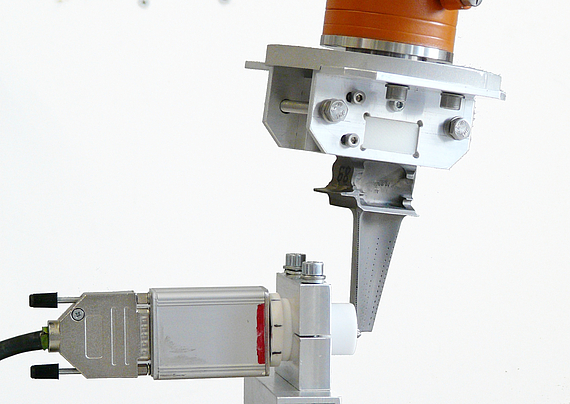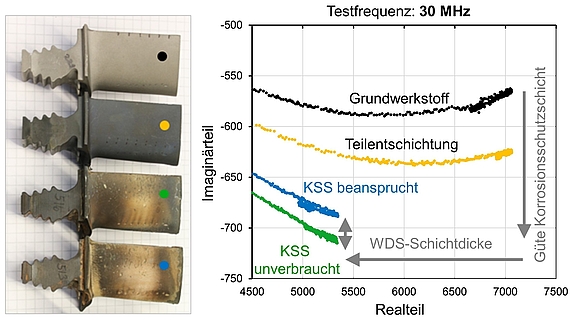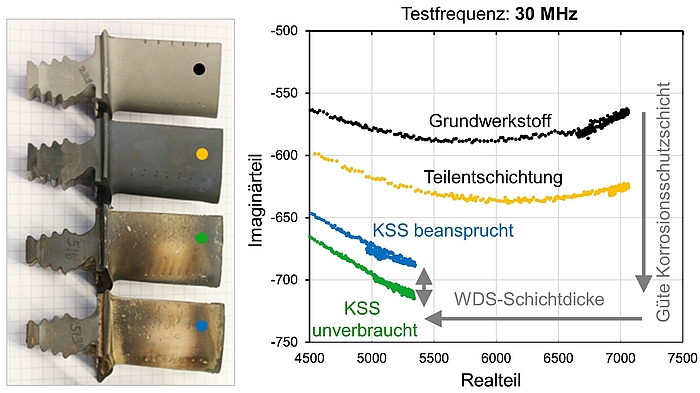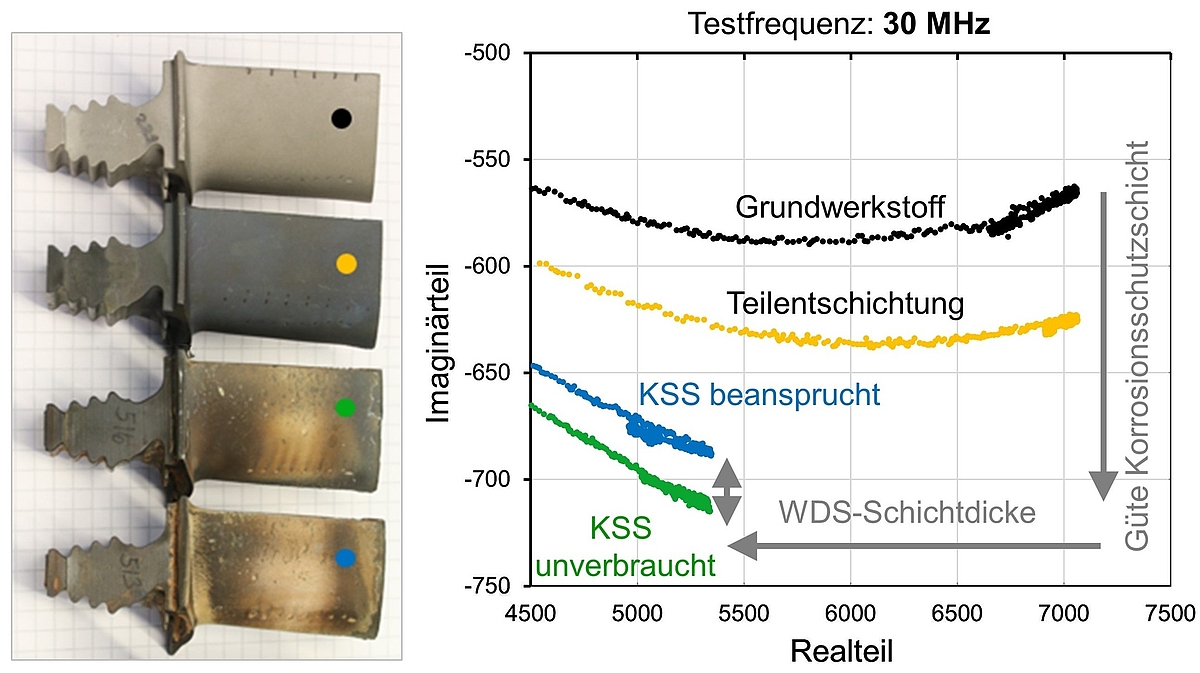Motivation and objectives



High demands on the performance and reliability of modern engines require the integrity of highly stressed engine components such as turbine, compressor and fan blading and their condition assessment during inspections and maintenance. During operation, the blading is exposed to extremely high thermal, corrosive, erosive and mechanical stresses. The components are designed as a component multilayer system according to that stress profile. The base and layer material has to fulfil highest demands required for continuous engine operation. The condition and integrity of engine blading are of strategic importance for engine reliability and operation safety. This places a stringent requirements on non-destructive testing techniques, material characterization and early damage detection. In order to be able to assess and evaluate a necessary repair requirements for stressed components and thus also be able to take these into account for the planning of the further regeneration path, a fast engine components investigation, which can already be carried out in the partially stripped engine, is becoming increasingly important.
Please note that activating the video will result in the transfer of data to the respective provider. Further information can be found in our privacy policy.
Play video
Video: Blisk inspection using induction thermography
Results
In the first funding period which was oriented on the particular base material and layer properties of turbine blades of the high-pressure turbine, basic research were carried out to map the test conditions via modeling. With the new development of a multi-parameter high-frequency eddy current technique and induction thermography with pulsed excitation in the megahertz range, a new field of application with regard to automated defect detection and classification, as well as material characterization of thin layer and component surface zones has been successfully developed on the example of highly-loaded turbine blades. Further areas of application are thin coatings on functional components, gliding surfaces or guides, as well as high-performance components with tight tolerances of surface zones in other capital goods.



The results of the second funding period describe non-destructive defect detection and material characterization in blade channel of turbine disc and blisk-type compressor with limited accessibility. Component testing and condition assessment of complex geometries was achieved by customizing the sensor and inductor properties. The determination of the damage depth in thick-walled components was realized by the new development of a remote field eddy current technique.



Current works and outlook
The third funding period aims to to develop a mobile and flexible electromagnetic testing system with adapted eddy current sensors, as well as a thermographic testing system with combined inductor mirror optics for defect detection. The purpose of the development is to evaluate the condition of stator and rotor blades directly at the partially stripped engine. Another subject of the research is the in situ detection and characterization of damage development as well as the changes in material properties under thermal and cyclic loading of regenerated samples and components compared to new parts. The changes in specimen are going to be investigated using a specially designed thermomechanical test rig with combined non-destructive testing techniques like eddy current, thermography and acoustic emission. The use of initially paramagnetic Ni-base materials at high temperatures in a sulfur-containing atmosphere (such as in the exhaust gas stream) leads to significant changes in the magnetic properties due to the local formation of ferromagnetic phases. In order to characterize, quantify and use as a condition indicator of the degree of high-temperature microstructural changes (hot gas corrosion) in turbine blade materials the development of a non-destructive electromagnetic testing technique based on harmonic analysis is planned.
Subproject leader
30823 Garbsen
Staff
30823 Garbsen
30823 Garbsen
Publications
International Scientific Journal Paper, peer-reviewed
-
(2016): Applications of High Frequency Eddy Current Technology for Material Characterization of Thin Coatings, In: Journal of Materials Science and Engineering 2016 (6), S. 185–191
DOI: 10.17265/2161-6213/2016.7-8.001 -
(2016): Turbine blade wear and damage – An overview of advanced characterization techniques, Materials Testing 58 (5), S. 389–394
DOI: 10.3139/120.110872
International Conference Paper, peer-reviewed
-
(2018): Near-Wing Multi-Sensor Diagnostics of Jet Engine Components, ASME Turbo Expo 2018: Turbomachinery Technical Conference and Exposition; Oslo, Norway, June 11–15, 2018
DOI: 10.1115/GT2018-76793 -
(2017): Advanced Characterization Techniques for Turbine Blade Wear and Damage, Procedia CIRP Bd. 59: ELSEVIER, S. 83–88
International Conference Paper, not peer-reviewed
-
(2016): Applications of high frequency eddy current technology for material characterization of thin coatings, Proceedings 12th International Conference The "A" Coatings 2016, S. 37–43, Garbsen: PZH Verlag
-
(2016): Material Characterization of Thin Coatings Using High Frequency Eddy Current Technology., World Conference on Non-Destructive Testing; WCNDT. München.
-
(2016): Applications of high frequency induction thermography in the megahertz range for material characterization of turbine components, Proceedings 12th International Conference The "A" Coatings 2016, S. 31–36, Garbsen: PZH Verlag
-
(2016): Non-Destructive Damage Detection and Material Characterization of Turbine Components Using Megahertz Range Induction Thermography in Pulsed Mode, In: 19th Proceedings of World Conference on Non-Destructive Testing; WCNDT. Munich, Germany
-
(2013): High Frequency Eddy-Current and Induction Thermography Inspection Techniques, 18th International Workshop on Electromagnetic Non-Destructive Evaluation. Bratislava, SK, 24.06.2013
National Scientific Journal Paper, not peer-reviewed
-
(2012): Nachweis von lokalen Schädigungen an Hochleistungsbauteilen mit Hochfrequenz Wirbelstromtechniken und Induktions-Thermografie, DACH-Jahrestagung 2012 Zerstörungsfreie Materialprüfung. Berlin: DGZfP
National Conference Paper, peer-reviewed
-
(2018): Entwicklung einer Hochfrequenz-Induktionsthermografie und -Wirbelstromtechnik zur Fehlerprüfung und Charakterisierung der Schichtsysteme von Triebwerksbeschaufelung im Schaufelkanal, DGZfP-Jahrestagung 2018; 7. bis 9. Mai, Leipzig.
National Conference Paper, not peer-reviewed
-
(2014): Schicht-und Bauteilfehlerprüfung mit HF-Wirbelstromprüftechnik und HF-Induktionsthermografie, 390. Sitzung des Arbeitskreises Niedersachen. Deutsche Gesellschaft für Zerstörungsfreie Prüfung. Garbsen, 30.01.2014
-
(2013): Assessment of used turbine blades on and beneath the surface for product regeneration. Generation of a damage model based on reflection, geometry measurement and thermography, CLEO 2013, 16.5.2013 München
Dissertationen
-
(2017): In-situ-Erfassung der Werkstoffumwandlung und Gefügeausbildung mittels Wirbelstromtechnik, Berichte aus dem IW 02/2017, PZH Verlag, Garbsen 2017
ISBN: 3959001347




